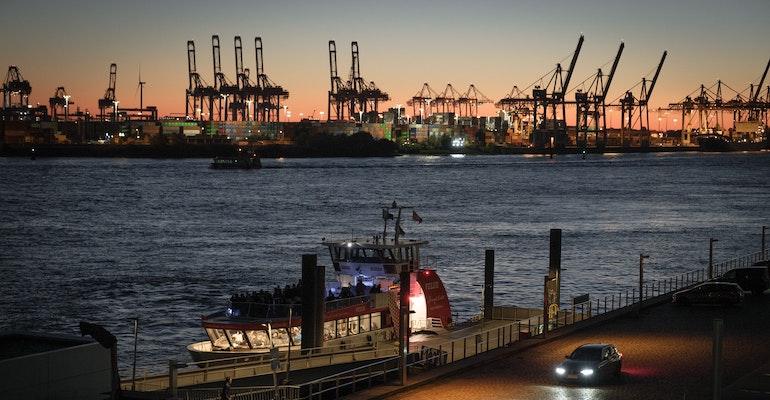[ad_1]
Much has been said about the increasing congestion situation in the European ports in recent months. While the European ports situation seems to be stabilizing, Germany’s ports continue to suffer with more than 2% of the global shipping capacity outside German ports at a standstill. There are multiple reasons why this is happening including labor issues, climate change, port capacities and the Russia-Ukraine conflict.
All-time high waiting times at Hamburg port
When we look at the historical weekly median port congestion for the port of Hamburg, we see an increasing trend over the last few months. In the strike weeks, the median vessel delay increased by about 4 hours, but vessels in the 75th percentile saw a sharp increase, with vessel wait times reaching 74 hours.
Increasing vessel waiting times at Hamburg Port (Jan – Sept 2022) while incoming traffic remains mostly stable
![Bar Chart (Vessel Delay) CAMTR (4)[1].jpg Bar Chart (Vessel Delay) CAMTR (4)[1].jpg](https://www.seatrade-maritime.com/sites/cet.com/files/Bar%20Chart%20%28Vessel%20Delay%29%20CAMTR%20%284%29%5B1%5D.jpg)
![DEHAM (2)[79].jpg DEHAM (2)[79].jpg](https://www.seatrade-maritime.com/sites/cet.com/files/DEHAM%20%282%29%5B79%5D.jpg)
At various times over the last three months, this congestion was partly accounted for by the port strikes in Germany and also the knock-on effects of the strikes in the UK ports. Hamburg is one of the top transhipment ports for inbound shipments to UK ports like Felixstowe, Thames and Liverpool and therefore impacted with diversions of vessels from UK ports to Germany. Port performance data showed an abnormal increase in the number of hours that vessels had to wait to call at the port.
However the congestion is not solely due to the labor issues. As climate change worsens, major waterways like the Rhine and Danube are becoming virtually impassable with historic drought levels, especially since the beginning of August. Such low water levels across Europe, but especially on the River Rhine, a key transport lane for Germany and Switzerland, added to the port congestion in Hamburg, Rotterdam as well as Zeebrugge.
A deeper look at the vessels waiting at the Hamburg port shows an interesting correlation between the vessel sizes and the waiting times.
Vessel size & capacity could be linked to waiting times
The top quartile of all vessels waiting at the Port of Hamburg deserves further investigation. Amongst the vessels waiting to berth, a quarter of vessels are waiting over 15x the median waiting time. Inspecting this further, we see a correlation between the vessel size or capacity and the waiting times.
The larger vessels with higher teu capacity have a higher chance of waiting for a long period before mooring at the port. Vessels with higher teu capacity are likely to spend 4 times longer than their counterparts waiting for berthing allocation.
If we take vessels smaller than 2,000 teu, these vessels have almost 0 median waiting time and around 10 hours waiting time for the 75th percentile. For vessels with capacity above 2,000 teu, the median waiting time goes up to 36 hours and the 75th percentile waiting time increases to 111 hours. Very few vessels below 5000 TEU capacity waited longer than 3 days whereas this waiting time seems more common for vessels above 5,000 teu capacity.
This is rather counterintuitive since larger vessels tend to get priority due to higher running costs like crew and fuel costs, port fees and likely demurrage fees. However, the low water levels and impact of labor unrest provides some explanation for this.
Larger vessels spending more time waiting for berth vs. smaller vessels (Hamburg Port, Jul – Aug 2022)
![Hamburg Port Waiting Time vs. TEU (2)[23].jpg Hamburg Port Waiting Time vs. TEU (2)[23].jpg](https://www.seatrade-maritime.com/sites/cet.com/files/Hamburg%20Port%20Waiting%20Time%20vs.%20TEU%20%282%29%5B23%5D.jpg)
Your options as a shipper
It could take upto two months to clear out the congestion across the various European ports given the knock-on effects of the vessels waiting.
Shippers should actively explore routing cargo via alternative ports or modes of transport. Consider reallocating shipments within the same purchase order across different sailing options and modes of transport in order to hedge against last minute disruptions. Gain real-time visibility on delays at a container or order level to manage risks more proactively. Setup exception alerts to manage customer expectations and production planning and avoid last minute fire-fighting.
Real-Time and Predictive Visibility Platforms enables exception alerts in case of delays at any ports including transhipment as well as updates on risk in port congestion. With continued disruptions, supply chains can no longer be managed with last minute information and relying on promised schedules but only through a proactive approach on exception management.
About the author: Nidhi Gupta is CEO and Co-Founder of Portcast, a Singapore-based logistics tech start-up that aims to make global supply chains dynamic and efficient using cutting-edge technology such as artificial intelligence (AI) and geospatial data. She is committed to building the next generation of logistics operating systems in order to make highly accurate predictions on how cargo moves across the world.
As an experienced strategy and logistics professional, Nidhi has over a decade of leadership and C-level consulting experience in Asia Pacific with the Deutsche Post DHL group. In her most recent
role as Senior Director of Engineering & Manufacturing Sector she was responsible for developing the growth strategy of the sector and leading transformational supply chain strategies for customers across Asia Pacific.
Copyright © 2022. All rights reserved. Seatrade, a trading name of Informa Markets (UK) Limited.
[ad_2]
Source link








